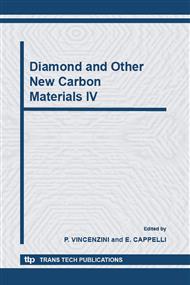p.61
p.67
p.73
p.77
p.83
p.93
p.103
p.113
p.119
Vacuum Thermionic Energy Conversion Based on Nanocrystalline Diamond Films
Abstract:
Vacuum thermionic energy conversion achieves direct conversion of heat into electrical energy. The process involves thermionic electron emission from a hot surface and collection of the electrons on a cold surface where the two surfaces are separated by a small vacuum gap. Results are presented which indicate that nanocrystalline diamond films could lead to highly efficient thermionic energy conversion at temperatures less that 700°C. A critical element of the process is obtaining a stable, low work function surface for thermionic emission. Results are presented which establish that N-doped diamond films with a negative electron affinity can exhibit a barrier to emission of less than 1.6 eV. Films can be deposited onto field enhancing structures to achieve an even lower effective work function. Alternatively, nanocrystalline diamond films prepared with S doping exhibit field enhanced thermionic emission and an effective work function of ~1.9 eV. The field enhanced structures can reduce the effect of space charge and allow a larger vacuum gap. The possibility of a low temperature nanocrystalline diamond based thermionic energy conversion system is presented.
Info:
Periodical:
Pages:
83-92
Citation:
Online since:
October 2006
Price:
Сopyright:
© 2006 Trans Tech Publications Ltd. All Rights Reserved
Share:
Citation:


